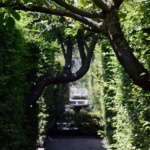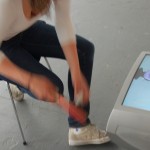While staying at Vacheresse, just south of Lake Geneva, we visited Yvoire, a medieval village…
Architects of the senses
Tutorial today with Klaas, following up a few of his tips here . The first one is about the architect Peter Zumthor.
Wiki:
Zumthor always emphasises the sensory aspects of the architectural experience. To him, the physicality of materials can involve an individual with the world, evoking experiences and texturing horizons of place through memory. He recalls places he once measured out at his aunt’s house through their sensual qualities. Here he echoes architectural practitioner and writer Juhani Pallasmaa who argues that, in a world where technologies operate so fast that sight is the only human sense which remains more immediately resonant (1996).
Zumthor’s Vals spa recounts the thinking he describes in his essay, making appeals to all the senses. The architect choreographs materials according to their evocative qualities. Flamed and polished stone, chrome, brass, leather and velvet were deployed with care to enhance the inhabitant’s sense of embodiment when clothed and naked. The touch, smell, and perhaps even taste of these materials were orchestrated obsessively. The theatricality of steaming and bubbling water was enhanced by natural and artificial light, with murky darkness composed as intensely as light. Materials were crafted and joined to enhance or suppress their apparent mass. Their sensory potential was relentlessly exploited with these tactics, Zumthor aimed to celebrate the liturgy of bathing by evoking emotions”
Peter Zumthor wrote the essay ‘thinking architecture’, in which he describes his earlies architectural experiences as ‘there was a time when I experienced architecture without thinking about it” – and goes on to describe the sensation of handling a particular door handle on a door that gave access to a garden: “a world of different moods and smells”.
Second tip: check Tom Lemaire: ‘met open zinnen’ – ‘with open senses’:
Quote: “The primary concern of philosopher and cultural anthropologist Ton Lemaire is the rehabilitation of the senses. With Open Senses, which forms the synthesis of Lemaire’s extensive philosophic oeuvre, places not only the ecological debate but also the question of our culture’s future in a new and broader perspective.
In the twentieth century the landscape disappeared from both painting and poetry, and this was no accident, according to Lemaire. The world has become an ever more artificial place, from which nature has gradually been eliminated. The natural landscape became the victim: from that point on man found himself in an environment that he himself had created. He became a narcissist in a world in which everything referred only to himself.
With great erudition Lemaire shows how this gradual loss of reality occurred in many areas at once. Modern philosophy made man into an all-powerful being who subjects the world to his will. Literature dissolved into a postmodern game of meanings that referred only to one another. Globalization made every place in the world interchangeable and abstract, uprooting man from the Earth.”
Third tip was to read Arjen Mulder’s ‘Over Media Theory’ – ‘About Media Theory’. We’ve had him as a lecturer and read parts of his book. Now read the whole book! Quote from Amazon: “Among students at universities and colleges of higher education, as well as in the written press, one can ascertain a growing interest in media theory. There is a conveyor belt of books about new media, but what seems to be missing is knowledge and understanding of the classical media theories of Ernst Cassirer, Susanne Langer, Harold Innis, Marshall McLuhan, Claude Shannon, Gregory Bateson, Vilém Flusser, Friedrich Kittler, and many others. In Understanding Media Theory, the ideas of these theoreticians and philosophers are explained and applied in a clear and accessible way–not by discussing the writers one by one, but by using real examples and analyzing them on the basis of concepts developed in media theory. Consequently, this volume is accessible to a broad public, though it is primarily intended for students and teachers of media studies.
The main thrust of media theory is the analysis of how a society is altered by the technical characteristics of the various media it encompasses. Media theory therefore examines popular culture as well as the arts, journalism as well as philosophy, scientific as well as general insights, mass media as well as individualized media. Media theory claims to offer an explanation for all historic and social phenomena. ”
Fourth tip: the work of Ilya Prigogine, belgian scientist of Russian extraction.
Quote: “Ilya Prigogine was born in 1917 in Moscow, Russia. His family fled Russia a few years later and settled in Brussels. He became a piano virtuoso, but in the end chose the sciences over the arts. He studied at the Brussels ULB, where he still is thead of the Solvay-institute for physics and chemistr. Since 1967 he is also director of the Ilya Prigogine Center of the University of Texas, Austin, USA. ”
“To say this in a different way: there are two types of human experience that are important. One is the experience of repetition: the sun that comes up, the tides, the repetitive. This is what mechanical laws are based on. But there is also creativity in mankind, creativity that we experience every day. Look at all these neolithic statuettes here, gathered from everywhere: China, Mexico, India,… What an explosion of creativity all over the world!”
| « More senses than six: Proprioception | <-- previous post | next post --> | About artists writing » |
|---|







